Without a doubt, early settlers started distilling alcohol the second it was possible though Australia’s first legal distillery was opened in 1822 by Thomas Haigh Midwood in Van Diemen’s Land. It was known as the Sorell Distillery in Hobart. Thomas Haigh Midwood died in September 1823, only getting to enjoy his distillery for one year[1][4]. Beer breweries were encouraged at the time, but distilleries were not permitted until Governor Macquarie realised that distilleries would stimulate grain production and that people were going to distill illegally in the hills anyway – he might as well get the excise tax benefits [6]. Up until 1856, Tasmania was still called Van Diemen’s Land, named after the governor general of the Dutch East Indies, Anthony van Diemen[2]. The name Tasmania came from Abel Tasman, who was the first European explorer to reach Van Diemen’s land and he knew how to kiss his boss’s ass really thoroughly! While Tasman missed meeting any Aborigines, they knew their land as ‘Trowunna’, ‘Trowenna’ or ‘Loetrouwitter’ [3].
Distilling in Tasmania grew rapidly in the next few years with another 15 distilleries opening before Governor John Franklin prohibited distilling in TAS in 1838 [5]. Legal distilling in Tasmania ceased for well over a century but the law did not affect mainland Australia.
In 1824, Robert Cooper, James Underwood and F.E. Forbes started Sydney Distillery in Paddington, Sydney, New South Wales, between Old South Head Road and Rushcutters Bay. James Underwood bought out the other two founders around the time of opening after some severe disagreements[11]. We haven’t been able to find out if Sydney distillery produced whisky, though it definitely produced rum and gin, if you know, please let us know! They malted, milled and distilled from grains, so it is possible they made some whisky, though it could have been drunk or sold before reaching the 2 year mark to be legally called whisky.
Underwood’s Sydney Distillery, later became Abercrombie and Company’s Glenmore Distillery in 1836. After suffering financial difficulty, it was then turned into a leather tannery [13].
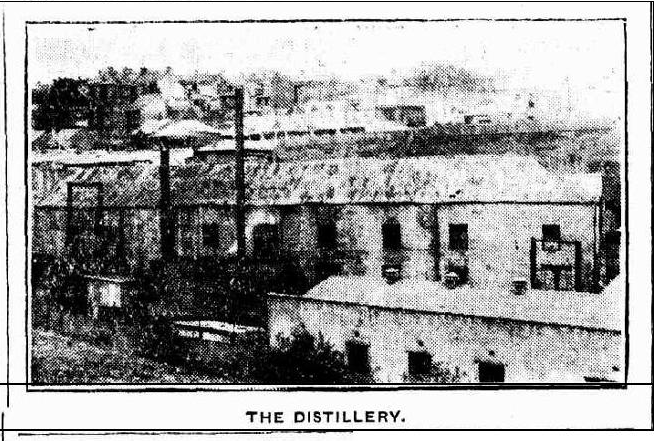
Glenmore Distillery, Sydney [34]
Robert Cooper then went on to start his own distillery around the same time, around 1825 (after being bought out of Sydney Distillery), called Brisbane Distillery on Paramatta Rd next to a small stream. Access to lots of quality water was extremely important to early distilleries which were almost always located on water sources. Brisbane Distillery had two 1200 gallon (about 4500 litre) stills, could grind 4000 bushels of grain and produce 2000 gallons of spirits every week [9]. Up until 1838, Brisbane Distillery had produced 85,000 gallons of spirit from grains and 55,000 gallons from sugar[10,12]. We also haven’t been able to find out if Brisbane Distillery produced whisky, but they malted and milled their own grain so it is definitely possible. Raw unaged spirit and gin were both definitely produced.
Japhet White also had a legal distillery running in Bathurst in 1828, producing spirits from grain, though information on this distillery is scarce. An article in the Australian newspaper states how much tax they were collecting from the distillery, the digital copy is blurry and hard to read [30]. Japhet White had a hard time setting the distillery up, they had stored two full years’ worth of grain harvests but hadn’t yet got permission to distill[31].
Sir William Milne, (1822-1895), born in Scotland and skilled in commerce, arrived in Port Adelaide in 1839. In 1845, Milne and his brother in law, John Disher of Oakbank set up set up a wine and spirits business and distillery, Milne and Co Distillers, producing a wide range of spirits [22]. In 1846 the pair also acquired another Adelaide spirits business belonging to Patrick Auld [23]. Milne and Co. was a highly successful business, carrying out manufacturing but also being exclusive agents for imported product lines. It would continue to run for over 100 years, despite changing owners several times. Sir William Milne reduced his role in the successful business in 1857 and moved into politics. Sir William Milne’s son, also William Milne, continued the business. A branch of the business was opened in WA in 1895 and the Thebarton Distilling Company was acquired by the company in 1897. Both whisky and gin from Milne and Co. won first place in the Royal Show, Melbourne for four years in a row, 1931-1934 and was highly regarded [29]. Milne and Co. was purchased by Gilbeys of London in 1946 [26]. Bottles of Milne and Co. whisky have shown up lately at Australian whisky auctions, such as Bond 7 [27], and Milne’s Well Matured Specially Selected Whisky [28]. If you’re lucky, you can still find one to buy!
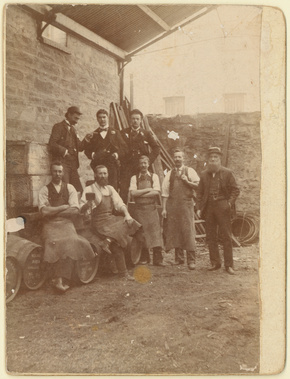
Milne and Co. employees with whisky barrels 1900 [24]

Sir William Milne[25]
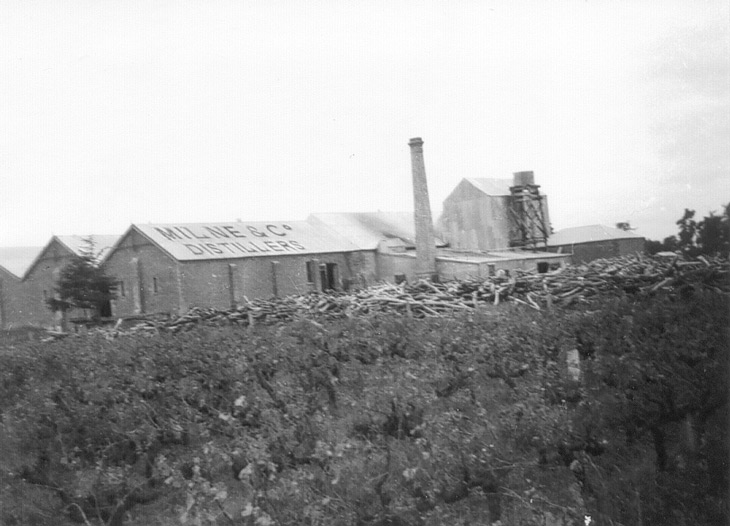
Milne and Co. Distillers circa 1930, Coonawarra South Australia
F.A Kumnick ran a successful distillery in Lobethal, Adelaide Hills, SA in the 1850’s. They produced mainly brandy, but also other spirits which had a great reputation and could have included whisky [32].
The next legal, large scale whisky distillery to emerge came shortly after the Victorian Distillation Act of 1862, which attempted to prevent unlawful distillation by providing a tightly regulated, legal means to produce Australian whisky, gin and other distilled spirits[7]. In 1862-1863, The Warrenheip Distillery was opened by Robert Dunn at the base of Mount Warrenheip with an excellent supply of clean spring water[8]. Spirits were produced from barley, oats and wheat. Warrenheip malted, kilned and milled its own grain. The mash tun consisted of a giant cast iron pot, manufactured by Messrs Hunt and Opie, of the Victoria Foundry. Mixing, moving and heating was all powered by a powerful steam engine. The company operated until 1872 when it was liquidated due to financial troubles, attempting to get around £10,000. It was purchased by Henry Brind and the name changed to Henry Brind and Co., Maltsters and Distillers[18].
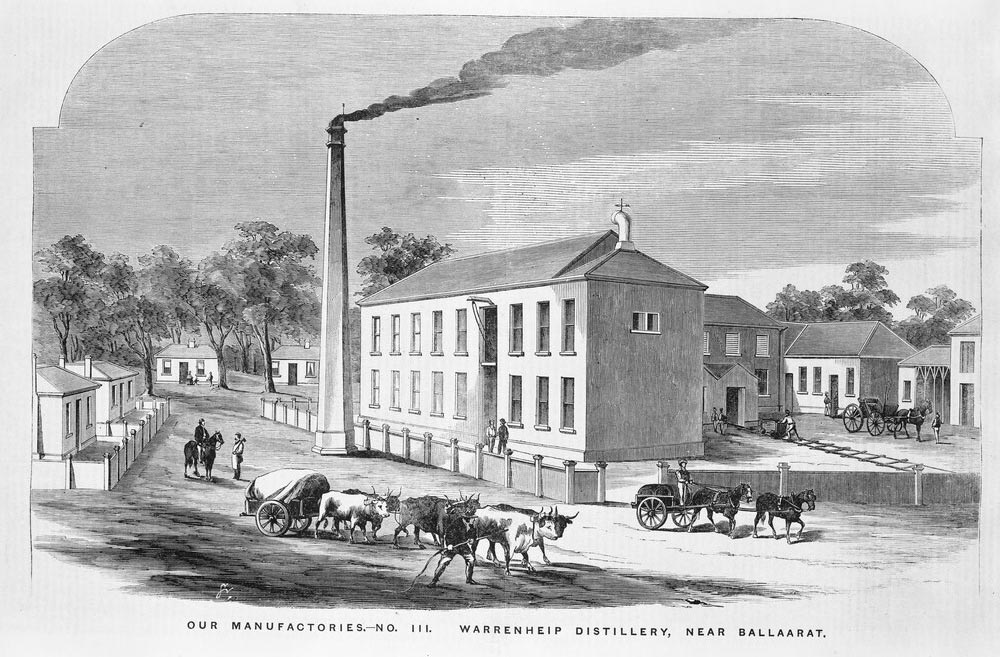
Castelmaine Brewery, built in 1856 in Newcastle NSW was a large beer producer but also opened a distilled spirits branch. The company was renamed to Castlemaine Brewery Maltings and Wine and Spirit Company Limited in 1883. We haven’t been able to find out if they produced their own spirits or simply operated as a bond store and merchant for other brands, please send us a message if you have information to complete this section. The building still stands and is listed on the NSW State Heritage Register.
1888 saw the construction of the Federal Distillery in Melbourne. A truly massive distillery, the 3rd largest in the entire world at the time, producing over a million litres of spirit per year. This was split between whisky, gin and brandy.
The 1901 Distillation Act provided a minimum still size of 2700 litres, which made it very difficult for craft distilleries to operate. The whisky distilling scene in Australia would be dominated by large companies for the years to come.
In 1924, Federal Distilleries Pty Ltd was created by the joining of four VIC distilleries which were: Federal Distillery, Warrenheip (which was now called Henry Brinds and Co.), Brehney Bros and Kennas Pty Ltd. Federal Distilleries released brands such as Brind’s Extra Matured Whisky and Old Court Whisky.
The massive Corio Distillery was built in Geelong in 1928, becoming Australia’s largest distillery, overtaking Federal Distilleries. By 1929, Corio Distillery was producing 500,000 gallons of Australian whisky per year, but wouldn’t release any until 1934, the whisky was aged at least 5 years in oak barrels [15]. Corio Distillery was built by Distillers Company Limited, a company which is now known as Diageo, the world’s largest spirits company. Diageo owns brans such as Jonnie Walker, Smirnoff, Tanqueray, Guinness, Captain Morgan and hundreds more [16]. Five Star Whisky by Corio became extremely popular and sold tens of millions of bottles, both in Australia and overseas. Before the release of Corio’s Australian whisky, the Australian market was completely dominated by Scotch whisky and Corio managed to turn this around. Domestic Australian production and consumption of whisky exceeded imported whisky for the first time. Alcohol consumption in Australia was high, previously making Australia one of Scotland’s top customers internationally. As Scotch whisky was aged for longer and priced higher, the whisky from Corio started to be seen as cheap rocket fuel and gradually fell out of favour with the general public. It definitely didn’t help that several pollution heavy industries moved in next door such as fuel and fertiliser refineries, the countryside around Corio wasn’t the same. If anyone has an open bottle we would love to try it! Luke McCarthy, author of The Australian Spirits Guide managed to track down some old Corio and Milne whisky bottles to taste and scored them quite highly [33].
In 1930, Federal Distilleries Pty Ltd, the Old Court Whisky Group and Corio Distillery all merged under a new company name of United Distilleries. [17]
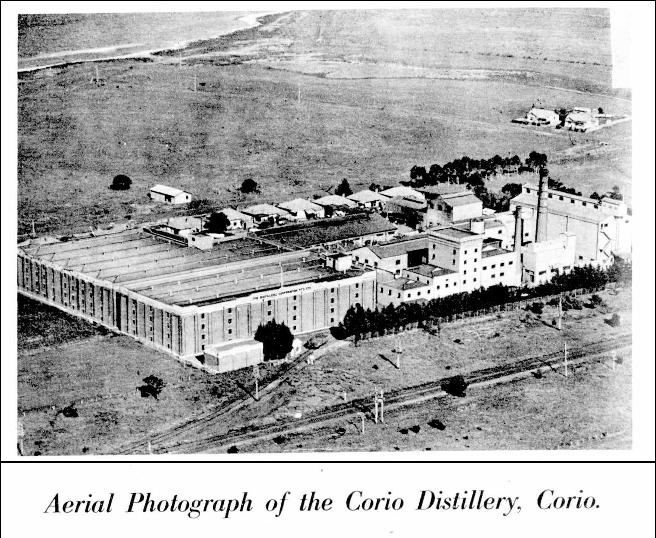
Corio Distillery [14]
In the 1960’s, Australian import duties on spirits from other countries were lowered, making Scotch Whisky and Bourbon much more affordable. Excise tax rates on alcohol were also increased significantly and are still amongst the highest in the world. Before this new law, Australian whisky distilleries had a huge price advantage, which offered significant protection. After the import tariffs were lowered, the Australian whisky industry slowly but steadily declined until 1989 when Corio Distillery closed.
In 1990, Bill Lark started to try and overturn the 1901 Distillation Act which stated:
“(f) There must be erected in the still-house:
(i) A still capable of exhausting in the case of a general distiller’s licence at least 675 litres of wash in an hour, and in the case of a wine distiller’s licence at least 225 litres in an hour, or a wash still capable of containing at least 2,700 litres, and also capable of containing double the quantity which the low wines or spirit still is capable of containing. In lieu of one still of the required capacity two or more stills aggregating the required capacity shall suffice.” [19]
Hence, it was very difficult for small craft distilleries to start out, massive financial backing was necessary to install equipment of such scale. Bill Lark started by talking to local Tasmanian MP Duncan Kerr, who then called the Federal MP Barry Jones. It turns out, both these MP’s came through with the goods and the law was overturned. Bill Lark then founded Lark Distillery in 1992 and paved the way for all craft Australian distilleries to come.
Sullivans Cove whisky distillery was setup shortly after Lark in 1994, in Sullivans Cove, Tasmania. It was then called simply Tasmania Distillery. In the early days, the quality of Sullivans Cove whisky was not what we know it to be today. Whisky takes a long time to mature, waiting for 12 years before payday just isn’t possible for most companies. Bottling whisky a bit too young and facing financial trouble, the company failed and in 1999 was bought by new owners. Bill Lark was hired to produce a quality single malt, who brought in his friend Patrick Maguire, who is the current head distiller of Sullivans Cove. Business continued to struggle and in 2003 the second owners group threw in the towel. Patrick Magquire still had some energy left so decided to purchase Sullivans Cove himself, along with new investors. [20]
In 2014, Sullivans Cove won World’s Best Single Malt Single Cask at the World Whisky Awards. This achievement completely changed the trajectory of Sullivans Cove, but also put Australian whisky on the map, internationally. The winning cask was HH0525, French Oak Single Cask.
Headlands Distilling Co., was founded in 2015, though wouldn’t start distilling whisky until 2016, planning for a Christmas 2020 first release! Being the only producer of an oak barrel aged spirit made from native Illawarra Plums, Headlands Distilling Co., is using the ex-Illawarra Plum casks to mature a whisky which will be a world’s first.
Scotch whisky laws are very strict on barrel type, what was in the barrel etc, the same is not true in Australia. We are starting to see some super innovative casks types appear. In 2018 Old Kempton Distillery in Tasmania released the first Red Gum cask single malt whisky, which was also seasoned with McWilliams Apera.
In 2020, Archie Rose Distilling Co., in Sydney won World’s Best Rye Whisky, another massive achievement for Australian distillers, using virgin oak casks and unconventional malted rye[21].
As of 2020, Australia has around 300 distilleries, many of them producing great whisky. Some are starting to scale, some are happy staying as small family businesses. Even though there are hundreds of distilleries, Australian made spirits are still only around 2% of domestic spirits consumption, with the greater community preferring to purchase the cheaper, imported products.
References
[1] https://www.cradlemountainwhisky.com/cradle-mountain-whisky-our-history
[2] Alexander, Alison (editor) (2005)The Companion to Tasmanian History Centre for Tasmanian Historical Studies, University of Tasmania, Hobart. ISBN 1-86295-223-X.
[3] https://www.utas.edu.au/library/companion_to_tasmanian_history/T/Tasmania%20name.htm
[4] Sorrel distillery cascade Thomas haigh midwood death https://trove.nla.gov.au/newspaper/article/1089965
[5] https://taswhiskytrail.com/history/
[6] Land Settlement in Early Tasmania: Creating an Antipodean England, https://books.google.com.au/books?id=bTJeskna35YC&pg=PA85&lpg=PA85&dq=sorell+distillery&source=bl&ots=5H-CrPt6Sd&sig=ACfU3U0_ErSLqqrZXQjEXZ7fqE3mxJNJuA&hl=en&sa=X&ved=2ahUKEwj9gcSahsTqAhXCXisKHSt9D40Q6AEwCXoECBsQAQ#v=onepage&q=sorell%20distillery&f=false
[7] Victorian Distillation Act of 1862 http://www.austlii.edu.au/au/legis/vic/hist_act/tlaa1887214.pdf
[8] 1865 ‘THE WARRENHEIP DISTILLERY.’, The Ballarat Star (Vic. : 1865 – 1924), 1 April, p. 4. , viewed 09 Feb 2018, http://nla.gov.au/nla.news-article112885760
[9] The Australian, 30 June 1929
[10] Minutes of Evidence taken before the Committee on Colonial Distillation; evidence of J.M. Bates, VPLC (1839), 1, (n.p.).
[11] Underwood, James (1771–1844) by D. R. Hainsworth http://adb.anu.edu.au/biography/underwood-james-2751
[14] Corio distillery image https://trove.nla.gov.au/newspaper/rendition/nla.news-article84386650.4.html?followup=b5f33de11c05aadd77514dd5a7ee1c7c
[15] Corio distillery https://www.intown.com.au/historic/the-corio-distillery.htm
[16] Diageo Brands https://www.diageo.com/en/our-brands/brand-explorer/
[17] Merger of Corio and Federal newspaper article https://trove.nla.gov.au/newspaper/article/58395445
[18] Henry Brind and Co. https://bih.federation.edu.au/index.php/Henry_Brind_and_Co.
[19] 1901 Distillation Act https://www.legislation.gov.au/Details/C2004H01100
[20] Sullivans Cove history https://sullivanscove.com/journal/25-years-sullivans-cove/
[21] Archie Rose World’s Best Rye Whisky https://archierose.com.au/shop/product/rye-malt-whisky
[22] Sir William Milne Biography http://adb.anu.edu.au/biography/milne-sir-william-4206
[23] Patrick Auld Biography http://adb.anu.edu.au/biography/auld-patrick-2911
[24] Milne and co employees photograph https://collections.slsa.sa.gov.au/resource/B+15675
[25] Sir William Milne Photograph https://collections.slsa.sa.gov.au/resource/B+11311
[26] Milne and Co. Newspaper article TROVE Advertiser (Adelaide, SA : 1931 – 1954), Thursday 24 October 1946, page 2
[27] Milne and Co. Bond 7 Whisky https://www.langtons.com.au/product/77550/247/nv/milne-and-co/bond-7
[28] Milne and Co whisky bottle https://www.nicks.com.au/milne-s-well-matured-australian-whisky-13-fl-ozs
[29] Milne and Co win Royal Show https://trove.nla.gov.au/newspaper/article/256646026?searchTerm=%22Milne%20%26%20CO.%22
[30] Bathurst Distillery Australian (Sydney, NSW : 1824 – 1848), Thursday 24 October 1839, page 4
[31] Japhet White petition to hurry up government https://trove.nla.gov.au/newspaper/article/32075221?searchTerm=%22bathurst%20distillery%22
[32] F.A. Kumnick, Bailliere’s SA Gazetteer and Road Guide of 1866-67
[33] Corio and Milne Whisky Review https://ozwhiskyreview.com.au/milne-co-corio-whisky-review/
[34] Glenmore Distillery Photo https://trove.nla.gov.au/newspaper/article/246004729?searchTerm=%27%27glenmore%20distillery%22
Special thanks to Karen Smith for tracking down a lot of these hard to find newspaper articles!
Negroni cocktail recipe
How to make the perfect Negroni This simple yet famous Italian cocktail is a great way to enjoy gin, especially Australian craft gin. As with most cocktails, the exact historical origins are cloudy, but it is commonly accepted that the Negroni came from Florence,...
The Three Ways to Make Gin
You might have just read out article, What is gin? Now that you know what it is, let’s delve a little deeper into how gin is made. There are three main methods: 1. Maceration Gin botanicals such as juniper, coriander, citrus peels, angelica root, orris root,...
How to make the perfect Australian martini
While the exact history of the martini is unknown, the Australian martini traces its lineage all the way back to 2019, with a release of a gin made exclusively from Australian native juniper, Boobialla. Coupled with a delicious Australian dry vermouth, the Australian...






Old Court Whisky was actually a vatting of a pure malt blend of Joshua’s, Captain Cook and Brind’s Whiskies released in 1924.
There was another distillery at Sandridge (Port Melbourne) being the Scotch Distillery Company operating in 1882.
Ref: Ovens and Murray Advertiser (Beechworth, Vic. : 1855-1918, Thursday 19 October 1882, page 8.
Let’s not forget Smiths Angaston Whisky – the best I have ever had, period!